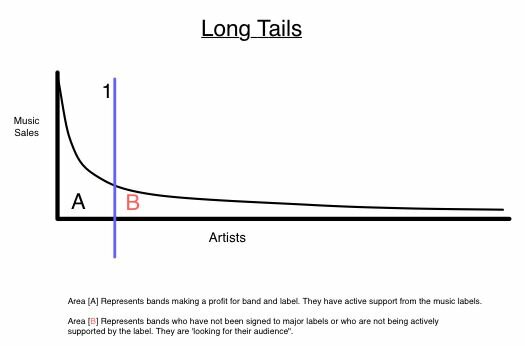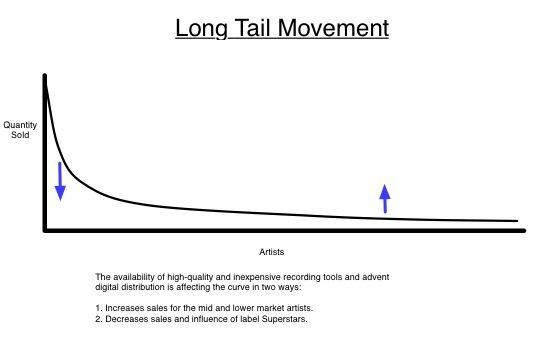What's Really Happening to the Music Industry
April 26, 2005
What's really happening in music.
The 80/20 rule is being obliterated.
Everyone in business - especially sales - knows about or has experienced the 80/20 rule. Eighty percent of your revenue comes from the top 20 percent of your customers. It's a truism in most industries including the music industry. The 80/20 rule is a guideline and not a hard and fast rule. But it is easy to see that until the last 5 years record labels made 80 percent of their revenue from 20 percent of their artists. And it probably would be even accurate to say that 20 percent of all would-be-musicians took 80 percent of all available music revenue. This 80/20 rule is nicely summed up in Chris Anderson's long tail blog.
Below is an illustration of the long tail.

Why does the long tail exist in music?
1. Success breeds success.
If you already know and like someone chances are you will buy their music. For example, Bo Bice will probably no longer be in the long tail since he has hit it big with American Idol.
2. Some people like Jazz.
.... or non-mainstream music and musicians. Tricked out accordion punk bands may have a small committed local following but they are unlikely to catch on to a larger audience.
Area [A] represent bands which are economically viable. Area [B] represents those which are not. Major record labels deal only with area A, which under point number 1, reenforces the long tail.
So what has happened in the last 5 years?
1. The computer has made the recording of professionally engineered music in your basement not only possible but affordable to almost anyone.
2. The Internet has made the distribution of music almost free.
And what did major labels do pre-1999? They produced and engineered music. They distributed music. (They stopped artist development sometime in the 80s.)
The Internet affect of the long tail.
All bands (with a label or not) have ready access to near-free distribution. If they can find their audience they have a much higher probability of becoming economically viable. This shifts the dividing line between area [A] and area [B] to the right.

The computer affect on the long tail.
With the ability of more artists to record high quality music will extend the tail of the curve with more artists, and it will shift the back end of the tail up. It is reasonable to assume that higher quality recordings will attract more purchasers/fans of the music. YEAH! for independent labels and artists.
Here is the painful part for the labels. Buyers of music have only so much money in their pocket if they start buying more music from the long tail they stop buying it from those artist in the power part of the tail hence the left side of the curve shifts down. OUCH! for the major labels.

Even though major labels are seeing decreasing sales, total music sales for the industry are almost certainly up! And this has NOTHING to do with illegal downloading. Mark Cuban suspects the same citing how other digital media with the same issues as music labels are showing increased sales.




What's Really Happening to the Music Industry
What's Really Happening to the Music Industry
What's Really Happening to the Music Industry